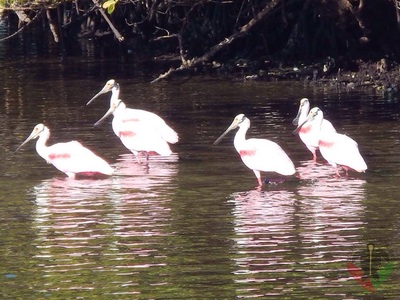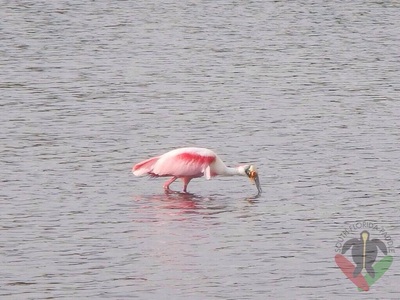Roseate Spoonbill

Adult Roseate Spoonbills have a bare greenish head ("golden buff" when breeding) and a white neck, back, and breast (with a tuft of pink feathers in the center when breeding), and are otherwise a deep pink. The bill is grey.
Like the American Flamingo, their pink color is diet-derived, consisting of the carotenoid pigment canthaxanthin. Another carotenoid,astaxanthin, can also be found deposited in flight and body feathers.The colors can range from pale pink to bright magenta, depending on age and location. Unlike herons, spoonbills fly with their necks outstretched. They alternate groups of stiff, shallow wingbeats with glides.
Behavior:
This species feeds in shallow fresh or coastal waters by swinging its bill from side to side as it steadily walks through the water, often in groups. The spoon-shaped bill allows it to sift easily through mud. It feeds on crustaceans, aquatic insects, frogs, newts and very small fish ignored by larger waders. In the United States a popular place to observe Roseate Spoonbills is "Ding" Darling National Wildlife Refuge in Florida. Roseate Spoonbills must compete for food with Snowy Egrets, Great Egrets, Tricolored Herons, and American White Pelicans.
Reproduction:
The Roseate Spoonbill nests in shrubs or trees, often mangroves, laying 2 to 5 eggs, which are whitish with brown markings. Immature birds have white, feathered heads, and the pink of the plumage is paler. The bill is yellowish or pinkish.
Threats:
Information about predation on adults is lacking. Nestlings are sometimes killed by turkey vultures, bald eagles,raccoons, and fire ants. In 2006, a 16-year-old banded bird was discovered, making it the oldest wild individual.




 RSS Feed
RSS Feed